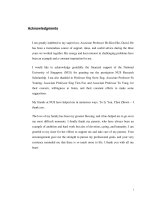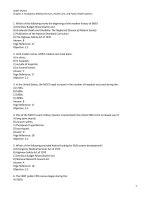Business statistics a decision making approach 6th edition ch05ppln
Bạn đang xem bản rút gọn của tài liệu. Xem và tải ngay bản đầy đủ của tài liệu tại đây (714.09 KB, 69 trang )
Business Statistics:
A Decision-Making Approach
6th Edition
Chapter 5
Discrete and Continuous
Probability Distributions
Business Statistics: A Decision-Making Approach, 6e © 2010 PrenticeHall, Inc.
Chap 5-1
Chapter Goals
After completing this chapter, you should be
able to:
Apply the binomial distribution to applied problems
Compute probabilities for the Poisson and
hypergeometric distributions
Find probabilities using a normal distribution table
and apply the normal distribution to business
problems
Recognize when to apply the uniform and
exponential distributions
Business Statistics: A Decision-Making Approach, 6e © 2010 PrenticeHall, Inc.
Chap 5-2
Probability Distributions
Probability
Distributions
Discrete
Probability
Distributions
Continuous
Probability
Distributions
Binomial
Normal
Poisson
Uniform
Hypergeometric
Business Statistics: A Decision-Making Approach, 6e © 2010 PrenticeHall, Inc.
Exponential
Chap 5-3
Discrete Probability
Distributions
A discrete random variable is a variable that can
assume only a countable number of values
Many possible outcomes:
number of complaints per day
number of TV’s in a household
number of rings before the phone is answered
Only two possible outcomes:
gender: male or female
defective: yes or no
spreads peanut butter first vs. spreads jelly first
Business Statistics: A Decision-Making Approach, 6e © 2010 PrenticeHall, Inc.
Chap 5-4
Continuous Probability
Distributions
A continuous random variable is a variable that
can assume any value on a continuum (can
assume an uncountable number of values)
thickness of an item
time required to complete a task
temperature of a solution
height, in inches
These can potentially take on any value,
depending only on the ability to measure
accurately.
Business Statistics: A Decision-Making Approach, 6e © 2010 PrenticeHall, Inc.
Chap 5-5
The Binomial Distribution
Probability
Distributions
Discrete
Probability
Distributions
Binomial
Poisson
Hypergeometric
Business Statistics: A Decision-Making Approach, 6e © 2010 PrenticeHall, Inc.
Chap 5-6
The Binomial Distribution
Characteristics of the Binomial Distribution:
A trial has only two possible outcomes – “success” or
“failure”
There is a fixed number, n, of identical trials
The trials of the experiment are independent of each
other
The probability of a success, p, remains constant from
trial to trial
If p represents the probability of a success, then
(1-p) = q is the probability of a failure
Business Statistics: A Decision-Making Approach, 6e © 2010 PrenticeHall, Inc.
Chap 5-7
Binomial Distribution
Settings
A manufacturing plant labels items as either
defective or acceptable
A firm bidding for a contract will either get
the contract or not
A marketing research firm receives survey
responses of “yes I will buy” or “no I will not”
New job applicants either accept the offer or
reject it
Business Statistics: A Decision-Making Approach, 6e © 2010 PrenticeHall, Inc.
Chap 5-8
Counting Rule for
Combinations
A combination is an outcome of an experiment
where x objects are selected from a group of n
objects
n!
C
x! (n x )!
n
x
where:
n! =n(n - 1)(n - 2) . . . (2)(1)
x! = x(x - 1)(x - 2) . . . (2)(1)
0! = 1
(by definition)
Business Statistics: A Decision-Making Approach, 6e © 2010 PrenticeHall, Inc.
Chap 5-9
Binomial Distribution
Formula
n!
x n
P(x)
p q
x ! (n x )!
P(x) = probability of x successes in n trials,
with probability of success p on each trial
x = number of ‘successes’ in sample,
(x = 0, 1, 2, ..., n)
p = probability of “success” per trial
q = probability of “failure” = (1 – p)
n = number of trials (sample size)
Business Statistics: A Decision-Making Approach, 6e © 2010 PrenticeHall, Inc.
x
Example: Flip a coin four
times, let x = # heads:
n=4
p = 0.5
q = (1 - .5) = .5
x = 0, 1, 2, 3, 4
Chap 5-10
Binomial Distribution
The shape of the binomial distribution depends on the
values of p and n
Mean
Here, n = 5 and p = .1
.6
.4
.2
0
P(X)
X
0
Here, n = 5 and p = .5
.6
.4
.2
0
P(X)
1
2
3
4
5
n = 5 p = 0.5
X
0
Business Statistics: A Decision-Making Approach, 6e © 2010 PrenticeHall, Inc.
n = 5 p = 0.1
1
2
3
4
5
Chap 5-11
Binomial Distribution
Characteristics
Mean
μ E(x) np
Variance and Standard Deviation
2
σ npq
σ npq
Where n = sample size
p = probability of success
q = (1 – p) = probability of failure
Business Statistics: A Decision-Making Approach, 6e © 2010 PrenticeHall, Inc.
Chap 5-12
Binomial Characteristics
Examples
μ np (5)(.1) 0.5
Mean
σ npq (5)(.1)(1 .1)
0.6708
μ np (5)(.5) 2.5
σ npq (5)(.5)(1 .5)
1.118
Business Statistics: A Decision-Making Approach, 6e © 2010 PrenticeHall, Inc.
.6
.4
.2
0
P(X)
X
0
.6
.4
.2
0
n = 5 p = 0.1
P(X)
1
2
3
4
5
n = 5 p = 0.5
X
0
1
2
3
4
5
Chap 5-13
Using Binomial Tables
n = 10
x
p=.15
p=.20
p=.25
p=.30
p=.35
p=.40
p=.45
p=.50
0
1
2
3
4
5
6
7
8
9
10
0.1969
0.3474
0.2759
0.1298
0.0401
0.0085
0.0012
0.0001
0.0000
0.0000
0.0000
0.1074
0.2684
0.3020
0.2013
0.0881
0.0264
0.0055
0.0008
0.0001
0.0000
0.0000
0.0563
0.1877
0.2816
0.2503
0.1460
0.0584
0.0162
0.0031
0.0004
0.0000
0.0000
0.0282
0.1211
0.2335
0.2668
0.2001
0.1029
0.0368
0.0090
0.0014
0.0001
0.0000
0.0135
0.0725
0.1757
0.2522
0.2377
0.1536
0.0689
0.0212
0.0043
0.0005
0.0000
0.0060
0.0403
0.1209
0.2150
0.2508
0.2007
0.1115
0.0425
0.0106
0.0016
0.0001
0.0025
0.0207
0.0763
0.1665
0.2384
0.2340
0.1596
0.0746
0.0229
0.0042
0.0003
0.0010
0.0098
0.0439
0.1172
0.2051
0.2461
0.2051
0.1172
0.0439
0.0098
0.0010
10
9
8
7
6
5
4
3
2
1
0
p=.85
p=.80
p=.75
p=.70
p=.65
p=.60
p=.55
p=.50
x
Examples:
n = 10, p = .35, x = 3:
P(x = 3|n =10, p = .35) = .2522
n = 10, p = .75, x = 2:
P(x = 2|n =10, p = .75) = .0004
Business Statistics: A Decision-Making Approach, 6e © 2010 PrenticeHall, Inc.
Chap 5-14
Using PHStat
Select PHStat / Probability & Prob. Distributions / Binomial…
Business Statistics: A Decision-Making Approach, 6e © 2010 PrenticeHall, Inc.
Chap 5-15
Using PHStat
Enter desired values in dialog box
Here: n = 10
p = .35
Output for x = 0
to x = 10 will be
generated by PHStat
Optional check boxes
for additional output
Business Statistics: A Decision-Making Approach, 6e © 2010 PrenticeHall, Inc.
Chap 5-16
PHStat Output
P(x = 3 | n = 10, p = .35) = .2522
P(x > 5 | n = 10, p = .35) = .0949
Business Statistics: A Decision-Making Approach, 6e © 2010 PrenticeHall, Inc.
Chap 5-17
The Poisson Distribution
Probability
Distributions
Discrete
Probability
Distributions
Binomial
Poisson
Hypergeometric
Business Statistics: A Decision-Making Approach, 6e © 2010 PrenticeHall, Inc.
Chap 5-18
The Poisson Distribution
Characteristics of the Poisson Distribution:
The outcomes of interest are rare relative to the
possible outcomes
The average number of outcomes of interest per time
or space interval is
The number of outcomes of interest are random, and
the occurrence of one outcome does not influence the
chances of another outcome of interest
The probability of that an outcome of interest occurs
in a given segment is the same for all segments
Business Statistics: A Decision-Making Approach, 6e © 2010 PrenticeHall, Inc.
Chap 5-19
Poisson Distribution Formula
x
( t ) e
P( x )
x!
t
where:
t = size of the segment of interest
x = number of successes in segment of interest
= expected number of successes in a segment of unit size
e = base of the natural logarithm system (2.71828...)
Business Statistics: A Decision-Making Approach, 6e © 2010 PrenticeHall, Inc.
Chap 5-20
Poisson Distribution
Characteristics
Mean
μ λt
Variance and Standard Deviation
σ 2 λt
σ λt
where
= number of successes in a segment of unit size
t = the size of the segment of interest
Business Statistics: A Decision-Making Approach, 6e © 2010 PrenticeHall, Inc.
Chap 5-21
Using Poisson Tables
t
X
0.10
0.20
0.30
0.40
0.50
0.60
0.70
0.80
0.90
0
1
2
3
4
5
6
7
0.9048
0.0905
0.0045
0.0002
0.0000
0.0000
0.0000
0.0000
0.8187
0.1637
0.0164
0.0011
0.0001
0.0000
0.0000
0.0000
0.7408
0.2222
0.0333
0.0033
0.0003
0.0000
0.0000
0.0000
0.6703
0.2681
0.0536
0.0072
0.0007
0.0001
0.0000
0.0000
0.6065
0.3033
0.0758
0.0126
0.0016
0.0002
0.0000
0.0000
0.5488
0.3293
0.0988
0.0198
0.0030
0.0004
0.0000
0.0000
0.4966
0.3476
0.1217
0.0284
0.0050
0.0007
0.0001
0.0000
0.4493
0.3595
0.1438
0.0383
0.0077
0.0012
0.0002
0.0000
0.4066
0.3659
0.1647
0.0494
0.0111
0.0020
0.0003
0.0000
Example: Find P(x = 2) if = .05 and t = 100
(t )x e t (0.50)2 e 0.50
P( x 2)
.0758
x!
2!
Business Statistics: A Decision-Making Approach, 6e © 2010 PrenticeHall, Inc.
Chap 5-22
Graph of Poisson
Probabilities
Graphically:
= .05 and t = 100
X
t =
0.50
0
1
2
3
4
5
6
7
0.6065
0.3033
0.0758
0.0126
0.0016
0.0002
0.0000
0.0000
P(x = 2) = .0758
Business Statistics: A Decision-Making Approach, 6e © 2010 PrenticeHall, Inc.
Chap 5-23
Poisson Distribution Shape
The shape of the Poisson Distribution
depends on the parameters and t:
t = 0.50
Business Statistics: A Decision-Making Approach, 6e © 2010 PrenticeHall, Inc.
t = 3.0
Chap 5-24
The Hypergeometric Distribution
Probability
Distributions
Discrete
Probability
Distributions
Binomial
Poisson
Hypergeometric
Business Statistics: A Decision-Making Approach, 6e © 2010 PrenticeHall, Inc.
Chap 5-25









